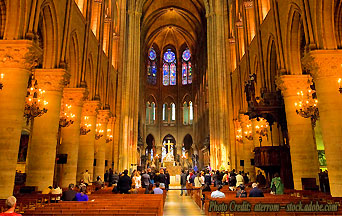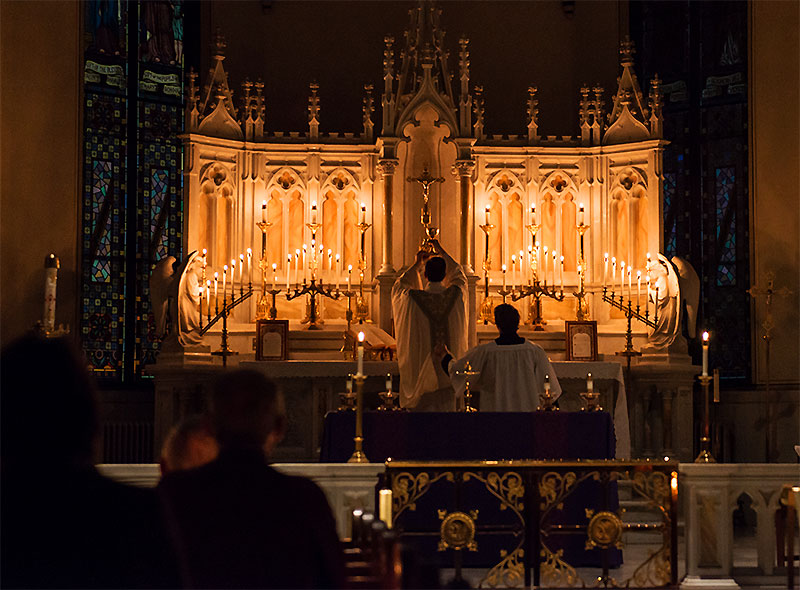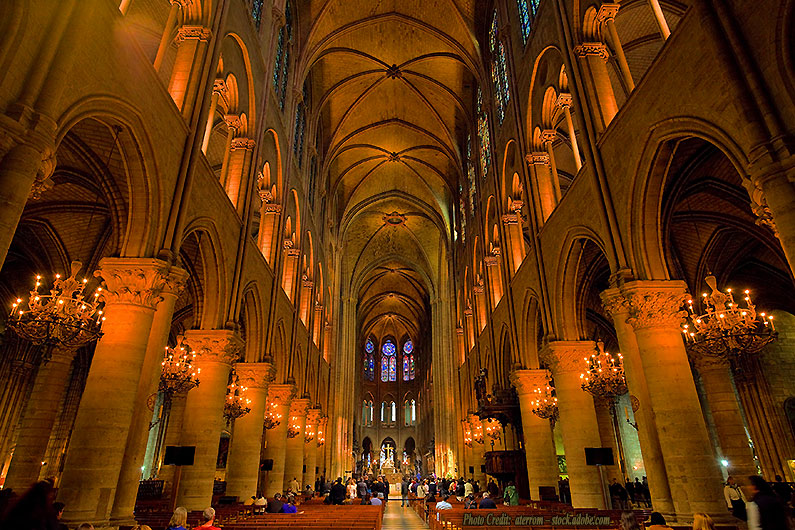
Paris is the City of Light, full of spectacle, beauty, and art. Yet in these dreary times of coronavirus lockdown, the theaters and concert halls are silent and dark. Artistic beauty finds no refuge from the draconian restrictions that constrain the body and stifle the soul.
The New York Times culture critic in Paris, Laura Cappelle, recently sought to fill the cultural void. She found solace in what she called the only authentic cultural event now re-allowed by authorities—the Catholic Mass. Indeed, she claims the Catholic Mass expressed by tradition in the city’s magnificent churches is the only setting where art can repose unperturbed. It is “the only show in town.”
Of course, the Mass is not a show, but there is something profound about her affirmation. The Church teaches that the Mass is an act of worship by which Catholics fulfill their obligation to adore God. Many times, the faithful do not realize the sublime beauty or the cultural richness expressed by the Mass. Sometimes it takes the eyes of an avowed nonbeliever to help worshipers appreciate the treasures in their midst.
Traditionally, the Church has done everything possible to appeal to humanity’s aesthetic sense. The primary aim of liturgy is God’s public worship, but that activity also produces intense beauty. Before modern innovations intervened, the Church’s ancient liturgies were spectacles of poetic expression and solemn ritual.
A God So Small, Yet Infinite; Infinite, Yet So Small!
Everything liturgical has meaning and purpose that teaches the truths of the Faith with great dignity and seriousness. Choral arrangements are composed having in mind heavenly joys, not earthly bliss. The Church understood that the beauty of her liturgy was an occasion for grace to act upon souls so that they might better know, love, and serve the Blessed Trinity.
Thus, Ms. Cappelle’s search for art and beauty at Mass makes sense, limited though it might be. She is drawn to the “elaborate costumes, choreographed flourishes, and live music” that she found when attending Masses celebrated at several Parisian parishes. At the church of Saint-Sulpice, she was particularly struck by a pre-dawn Rorate Mass that starts in darkness, illuminated only by candlelight, and ends with the first rays of the sun peeking through the windows. Celebrated during Advent, the Rorate Mass symbolizes the Light of Christ, which dawns shortly after on Christmas Day.

Unfortunately, the author’s perspective is restricted to the esthetic sphere, in which she circulates. Her standard of comparison is solely theater and the performing arts. She is impressed, however, by “the ritualistic nature of the event, the dramatic buildup from scene to scene – even the slightly labored monologues.” She witnesses a wide range of styles from warm and simple intimacy to “old-school pomp, with full processions and choreographed genuflections.” The Church understands art and therefore masters that dramatic tension found in the “push and pull between performance and solemnity, flamboyance and restraint.”
Why We Need Beauty in Our Lives
The music at the churches also enchants with a wide variety of choirs and organists. The acoustics of the ancient churches and their fine organs provide an atmosphere for the appreciation of classical composers and sacred music. The author is exposed to Gregorian chant, which she describes as “a sacred, virtuosic form” from the Middle Ages, which expresses “unshowy beauty.”
The art critic also observes those attending the service, whom she finds surprisingly young. All is peaceful and meditative as those present mix “quiet reflection and togetherness” in their soaring search for union with God. These various elements come together to present an otherworldly experience that touches the sublime.

© Photo Credit: aterrom – stock.adobe.com
The greatest spectacle for her was at the parish of Saint-Roch, known as the “church of artists.” What draws the artists there is the celebration of the traditional Latin Tridentine Mass in all its splendor. The author is amazed at the over 400 people she finds at the church, the largest crowd she has seen indoors since the pandemic began.
At this Mass, she comes the closest to having a religious experience, commenting that she “was moved, at Mass, by the love and devotion I recognized in many attendees.” She quickly likened it, however, to similar feelings she experiences at the theater. Nevertheless, the Mass struck a deep chord. She defends the churchgoers against critics in the secular arts who think churches should be locked down: “there is no reason to begrudge believers their worship.”
Science Confirms: Angels Took the House of Our Lady of Nazareth to Loreto
Laura Cappelle’s report has lessons for Catholics.
The first is that the Church’s traditional splendor is extremely attractive to postmodern souls. Through her, even The New York Times records the sublime beauty found in the ancient liturgy. The report refutes the myths about the unattractiveness of the traditional Church. Indeed, the author is surprised to find young people and artists drawn to the Mass. Catholics would do well to take notice. Many people might convert to the Faith if exposed to the grand apostolate of beauty.
Secondly, what attracts people to the Church is not social-justice sermons, dreary contemporary music, or cheap imitations of the modern world. People are searching for authenticity, certainties, and truth. The art of the Church expresses profound doctrines, firm teaching, and long tradition. When truth and moral goodness intermingle, they give forth a beauty that cannot fail to speak to those seeking God. Only the Church can quench the insatiable thirst for the sublime that is so much a part of human nature.
Finally, a return to beauty is only possible with a return to God, about whom Saint Augustine wrote: “Too late have I loved Thee, O Beauty so ancient and so new. Too late I have loved thee.” The postmodern world is rapidly exhausting itself. Let’s hope that—soon—a chastened humanity will come to see the foolishness of abandoning the ways of beauty and will take those words of the saint to heart.
As seen on The Catholic Thing.
Photo Credit: © aterrom – stock.adobe.com

